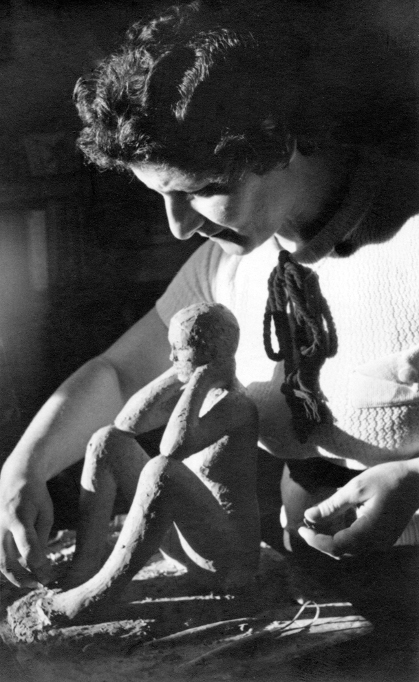Alis Guggenheim
Alis Guggenheim, was a Jewish painter, sculptor and ceramic painter from Switzerland. She was close friends with Max Bill, Karl Geiser, Richard Paul Lohse, Max Raphael and Hans Heinz Holz.(* 8. März 1896 in Lengnau; † 2. September 1958 in Zürich)
Alice Guggenheim, the third of seven children, grew up in Lengnau under modest circumstances. Her father was a cattle dealer and the parnas of the Jewish congregation. The family moved to Zürich in 1910, where Alice was apprenticed to a clothesmaker. In 1915 she fell in love with the Russian law student and revolutionary Mischa Berson, who sparked her enthusiasm for socialist ideas. In 1916 she opened her own fashion salon in Zürich. Three years later, in 1919, she boarded a Red Cross train to Moscow with Mischa Berson, with the aim of contributing actively to the future of the Soviet Union. She worked as a seamstress, studied Russian and joined the Communist Party. She lived in Kiev for a short period of time and on June 16, 1920 she gave birth in Moscow to a daughter Ruth. She drove back to Switzerland with her daughter at the end of August, where she took over her fashion salon again and began sculpting after working hours. She wanted to attend the School of Applied Arts in Zürich but was not accepted. She met the sculptor Karl Geiser in 1924 and was able to work in his studio. Having decided to become a fine artist, she sold her fashion salon, and changed the spelling of her first name to Alis and began making figurative sculptures and drawings.
The works she exhibited at the 1926 autumn exhibition of the Zürich Kunsthaus enjoyed the encouraging approval of fellow sculptors Hermann Haller, Alexander Soldenhoff and Ernst Kissling. In 1928, she showed her first large sculpture, a nude titled Frau (Woman, 1928), at the Schweizerischen Ausstellung für Frauenarbeit (Swiss Exposition of Women's Work, SAFFA). The art historian and philosopher Max Raphael, who had emigrated from Germany, published the first review of her work in the newspaper Tages-Anzeiger in 1932. A substantial correspondence testifies to her friendship with Raphael. Guggenheim lived and worked in Paris from 1932 to 1935. In 1936 a small circle of politically and artistically committed intellectuals began congregating at her studio in Zürich: Fritz Platten and Emil Ludwig discussed Soviet Russia, Friedrich Wolf read excerpts from his manuscripts and Hans Mühlestein spoke about Ferdinand Hodler. Other regulars included Richard Paul Lohse, Clément Moreau (Carl Meffert) and Lea and Hans Grundig. The late 1930s saw an increase of emigrants visiting her studio as well.
In 1942 Alis Guggenheim moved to Muzzano in the Canton of Ticino. She began painting, especially landscapes, and earned a living by decorating ceramic plates and jugs. She made several journeys to Italy and France between 1946 and 1953.
A cycle of small-format paintings made around 1950 shows scenes of her Jewish childhood in Lengnau. In 1954 she was awarded the art prize of the Swiss Federation of Jewish Communities (SIG), followed by a solo exhibition mounted at the city-run Galerie zum Strauhof in Zürich. Her art attracted increasing attention: she was represented at an exhibition of the Kunstmuseum in Bern in 1955; the city and canton of Zürich acquired several works; and one of her paintings was even purchased by the Swiss Confederation.
A 1992 retrospective of her ouevre at the Aargauer Kunsthaus Aarau was accompanied by a thoroughly documented publication. The Präsidialdepartement (Department of the Mayor) in Zürich mounted an exhibition of her work at the Town Hall in 1996.
It was extremely challenging for Alis Guggenheim to establish herself as an artist in Zürich. Her struggle for equality in a male-dominated profession met with undisguised opposition, as deftly described in a resumé that she wrote in 1944: «For the Swiss I am just a Jewess. For the Jews I am just a Communist. For the Communists I am just an artist. For the artists I'm just a woman. For the women I am just an unmarried female with a child. (Actually I'm sorry I didn't have twelve.)».
Frau, the above-mentioned life-sized bronze, was a highlight of her early work. The committed woman and artist rendered in Guggenheim's sculpture stands upright, confident, her feet firmly planted on the ground - in striking contrast to the dainty elegance of the figures created by her male colleagues, which liberally embellish public parks and private gardens.
The landscapes painted after 1942 in Ticino testify to the artist's profound appreciation of her surroundings. The topographical features of nature are mirrored in a conspicuously architectural treatment of landscapes that fill the entire canvas, often with no horizon line.
The paintings around 1950 that record memories of her childhood in Lengnau (canton of Aargau) play a special role in Guggenheim's oeuvre. Enlisting a deliberately «naïve» syntax, she painted scenes of the religious ceremonies and customs practiced in the two Jewish communities of Lengnau and Endingen.
Works: Israel Museum, Jerusalem, Jüdisches Museum der Schweiz, Basel, Aargauer Kunsthaus, Kunstsammlung Stadt Zürich, Nachlass Heussler, Zürich.
Urs Hobi, 1998, www.sikart.ch
